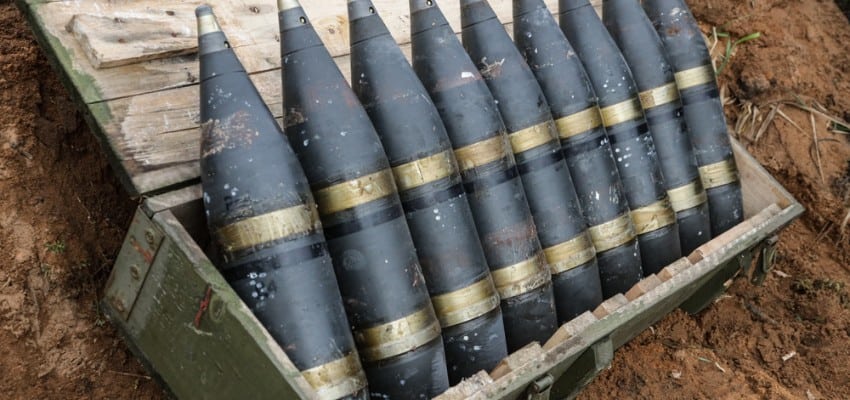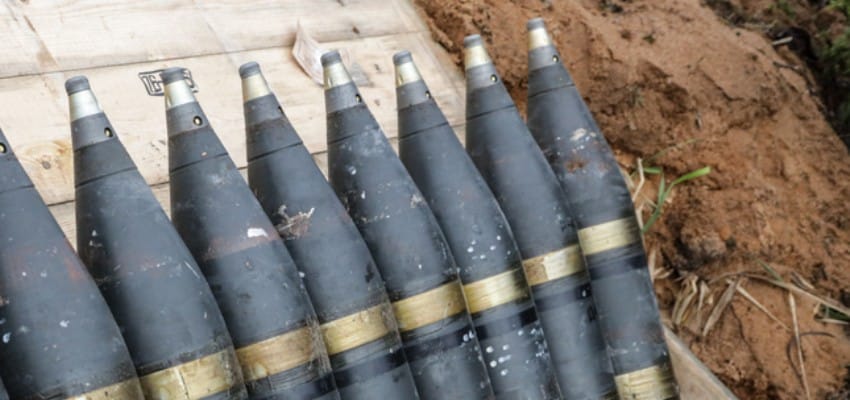|
|
Content Assessment: A Breakdown of Command? Ukraine Conflict Assessments in Maps (April 28 – 30, 2022)
Information - 94%
Insight - 98%
Relevance - 92%
Objectivity - 92%
Authority - 93%
94%
Excellent
A short percentage-based assessment of the qualitative benefit of the post highlighting the recent Ukraine conflict assessments in maps from the Institute for the Study of War.
Editor’s Note: One of the most accurate and detailed sources for ongoing updates on the Ukraine crisis is the Ukraine Conflict Update from the Institute for the Study of War. The Institute for the Study of War (ISW) is a 501(c)(3) organization and produces strictly non-partisan, non-ideological, fact-based research. ISW seeks to promote an informed understanding of war and military affairs through comprehensive, independent, and accessible open-source research and analysis. ISW’s research is made available to the general public, military practitioners, policymakers, and media members. Providing a daily synthesis of key events related to the Russian aggression against Ukraine, ISW updates may benefit cybersecurity, information governance, and legal discovery professionals as they follow the business, information technology, and legal trends and trajectories impacted by and stemming from the current Ukraine conflict.
Assessment and Maps*
Ukraine Conflict Assessments – An Overview in Maps
- Institute for the Study of War (ISW), Russia Team
- Critical Threats Project (CTP), American Enterprise Institute
General Assessment Background Info
- ISW systematically publishes Russian campaign assessments that include maps highlighting the assessed control of terrain in Ukraine and main Russian maneuver axes.
- These maps augment daily synthetic products that cover key events related to renewed Russian aggression against Ukraine.
The Russian Offensive Campaign Assessments
- April 30, 2022
- By Mason Clark, Karolina Hird, and George Barros
Further Russian reinforcements to the Izyum axis are unlikely to enable stalled Russian forces to achieve substantial advances. Elements of unspecified Eastern Military District units and several air-defense assets are reportedly deploying from Belgorod to the Izyum front to support likely degraded Russian units attempting to advance south of the city. These forces are unlikely to enable Russian forces to break the current deadlock, as Russian attacks remain confined to two major highways (toward Slovyansk and Barvinkove) and cannot leverage greater numbers. Several successful Ukrainian counterattacks out of Kharkiv city in the last 72 hours have additionally recaptured a ring of suburbs north and east of the city and may additionally force Russian forces to redeploy units intended for the Izyum axis to hold these positions. Russian forces appear increasingly unlikely to achieve any major advances in eastern Ukraine, and Ukrainian forces may be able to conduct wider counterattacks in the coming days.
Key Takeaways
- A Ukrainian counteroffensive out of Kharkiv City will likely alleviate pressure on parts of the city that have suffered the most from Russian shelling and may force Russian troops from Izyum to re-deploy northward to support forces maintaining the partial encirclement of Kharkiv.
- Additional Russian forces are deploying to the Izyum front but are unlikely to enable any major advances.
- Russian troops did not make any confirmed advances to the southwest or southeast of Izyum or to the west of the Donetsk-Luhansk frontline.
- Russian forces in Kherson are pausing major offensive operations to improve their tactical positions and regroup to prepare for a renewed offensive to capture the administrative borders of Kherson.
- Russian occupation forces in Mariupol announced plans to consolidate their control over the city and intend to return Ukrainian citizens forcibly deported into Russia at some point in the future.
- April 29, 2022
- By Karolina Hird, Mason Clark, and George Barros
Russian forces made limited advances west of Severodonetsk on April 29 but remain stalled south of Izyum. Ukrainian forces in eastern Ukraine are likely successfully conducting a maneuver defense rather than holding static positions, redeploying mechanized reserves to resist attempted Russian advances. Concentrated Russian artillery is enabling minor Russian advances, but Ukrainian positions remain strong. Limited Ukrainian counterattacks around Kharkiv city may additionally force Russian forces to redeploy units intended for the Izyum axis to hold these positions.
Key Takeaways
- Russian forces likely intend to leave a minimal force in Mariupol necessary to block Ukrainian positions in Azovstal and prevent partisan actions and are deploying as much combat power as possible to support offensive operations elsewhere.
- Ukrainian forces are successfully slowing Russian attacks in eastern Ukraine, which secured only minor advances west of Severodonetsk and did not advance on the Izyum front in the last 24 hours.
- Ukrainian counterattacks in Kharkiv are unlikely to develop into a major counteroffensive in the coming days but may force Russia to redeploy forces intended for the Izyum axis to hold their defensive positions around the city.
- Ukrainian intelligence continued to warn that Russian false flag attacks in Transnistria are intended to draw Transnistria into the war in some capacity and coerce Moldova to abandon pro-European policies.
- April 28, 2022
- By Mason Clark, George Barros, and Kateryna Stepanenko
Russian offensive operations in eastern Ukraine made minor advances on April 28. Russian forces attacking southwest from Izyum likely seek to bypass Ukrainian defenses on the direct road to Slovyansk. Russian forces continued shelling and minor attacks along the line of contact in eastern Ukraine but did not secure any gains in the past 24 hours. Additional Russian reinforcements continue to deploy to Belgorod to support the Izyum advance. Ukrainian defenders in Mariupol’s Azovstal Steel Plant continue to hold out against heavy Russian artillery and aerial bombardment, including the likely use of multi-ton “bunker-buster” bombs against a Ukrainian field hospital.
Ukrainian news outlet Defense Express reported on April 27 that Russian Chief of the General Staff Valery Gerasimov will take personal command of the Russian offensive in the Izyum direction. Citing unspecified Ukrainian military sources, Defense Express stated that Gerasimov is already in-theater and will command the offensive “at the operational and tactical level” and claimed the Russian military failed to create a single command structure under Southern Military District Commander Alexander Dvornikov. ISW cannot independently confirm this report. However, ISW previously assessed that Dvornikov’s appointment as overall commander in Ukraine would not solve Russia’s command and control challenges and likely strain his span of control. If confirmed, the appointment of Russia’s senior general officer to command tactical operations indicates both the importance of the Izyum drive to Russia’s war in Ukraine and the breakdown in the Russian military’s normal chain of command.
Key Takeaways
- Russian strategic bombers likely targeted a Ukrainian field hospital in the Azovstal Steel Plant. The remaining Ukrainian defenders are likely running low on supplies.
- Russian attacks southwest of Izyum likely seek to outflank Ukrainian defenses on the direct road to Slovyansk and have made tactical gains in the last 24 hours.
- Russian forces continued tactical ground attacks and shelling along the entire line of contact in eastern Ukraine but did not secure any major advances.
- Donetsk People’s Republic (DNR) Head Denis Pushilin stated that the DNR will postpone local Victory Day celebrations planned for May 9 until “the complete victory and the expansion of the DNR” to control Donetsk Oblast, though the Kremlin remains likely to attempt to claim some sort of victory on May 9.
- Russian forces conducted several locally successful attacks from Kherson toward Mykolaiv.
- Russian and proxy forces continued to mobilize in Transnistria and set conditions for a false flag attack.
We do not report in detail on Russian war crimes because those activities are well-covered in Western media and do not directly affect the military operations we are assessing and forecasting. We will continue to evaluate and report on the effects of these criminal activities on the Ukrainian military and population and specifically on combat in Ukrainian urban areas. We utterly condemn these Russian violations of the laws of armed conflict, Geneva Conventions, and humanity even though we do not describe them in these reports.
Ukraine Conflict Maps - 042822-043022
Read the latest Ukraine Conflict updates from the Institute for the Study of War
* Shared with direct express permission from the Institute for the Study of War (ISW).
About the Institute for the Study of War Research Methodology
ISW’s research methodology relies on both primary and secondary sources, enabling researchers to develop a comprehensive understanding of the situation on the ground. In order to analyze military and political developments in any given area, ISW’s research analysts must wholly understand the systems of enemy and friendly forces. They must also understand the population demographics, physical terrain, politics, and history of that area. This lays the analytical foundation for understanding the reasons for particular developments and fulfilling their assigned research objectives. ISW analysts also spend time in places like Iraq, Afghanistan, and elsewhere in order to gain a better understanding of the security and political situation and to evaluate the implementation of current strategies and policies. Our researchers compile data and analyze trends, producing a granular analysis of developments in areas of research, producing an accurate, high-resolution, timely, and thorough picture of the situation. ISW’s research methodology guarantees its success and commitment to improving the nation’s ability to execute military operations, achieve strategic objectives, and respond to emerging problems that may require the use of American military power.
About the Institute for the Study of War
The Institute for the Study of War advances an informed understanding of military affairs through reliable research, trusted analysis, and innovative education. We are committed to improving the nation’s ability to execute military operations and respond to emerging threats in order to achieve U.S. strategic objectives. ISW is a non-partisan, non-profit, public policy research organization.
Learn more, get involved, and contribute today.
Additional Reading
- [Annual Update] International Cyber Law in Practice: Interactive Toolkit
- Data Embassies: Sovereignty, Security, and Continuity for Nation-States
Source: ComplexDiscovery























